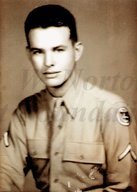
|

|
|
|
|
"I think so many things that I remember were the good things that happened to us," he recalls. "I just remember I was cold and miserable." That's how Raymon recalls service as an infantryman in Europe. Born in Castor, Louisiana, he moved with his family as a child to Minden. Later his father, a butcher, took the family to towns in Texas, and then to Shreveport, where Raymon graduated from Fair Park High School in 1940. He enlisted in the Army Specialized Training Program (ASTP) on December 14, 1942, while attending Centenary College. "I enlisted because I wanted to be in the ASTP rather than being drafted," he recalls. "I was afraid if I got drafted I'd get sent to the infantry which is where I ended up anyway." He was sent to Ohio State University in that program, but ASTP was soon terminated. Raymon was ordered to the 405th Infantry Regiment, 102nd Infantry Division. He arrived at Fort Dix, New Jersey in late September of 1944 uncertain of his overseas destination. "When they issued us the wool uniforms about the last week we were there, then we knew," he recalls. He sailed on a Norwegian cruise ship to Cherbourg, France. The 102nd was sent to Liege, Belgium, to relieve the Second Armored Division. Raymon was promoted to assistant squad leader, usually over eight men instead of the usual twelve. He says they were always under-strength. "We were kind of lucky to have ten," he says. Raymon remained on the front lines from October "until after Thanksgiving" before he had a hot shower, clean clothes, and a physical. All suffered from bad colds, diarrhea, and filth. All smoked or "learned to smoke," he says, with cigarettes included in all rations. A sniper shot him in a shoulder on his second day back in action. He recuperated in England during the Battle of the Bulge. After his hospital stay he returned to the front, and later crossed the Rhine, reporting "actually very little fighting," in his unit sector. One day his platoon stumbled across the inventory of a liquor store in a basement. "The gang celebrated that night," he recalls. As he handed out bottles of champagne to a passing armored column, one tanker told him of the death of Franklin Roosevelt. Raymon saw an early German jet in a hangar, and witnessed the aftermath of atrocities at concentration camps. He helped re-form a regimental band, and then assisted in publishing a newspaper from a captured print shop. He wrote stories under a pseudonym, O. Ray Lafaye, taken from his middle name, Lafayette. Raymon was shipped home in January of 1946, and was discharged at Camp Shelby near Hattiesburg, Mississippi. He returned to Centenary College on the GI Bill, where he majored in geology. He went to work for the Boy Scouts of America, and remained in scouting for twenty-five years before retiring. He later bought and ran a pet store. Raymon earned a Bronze Star and a Combat Infantryman Badge among other medals. |


